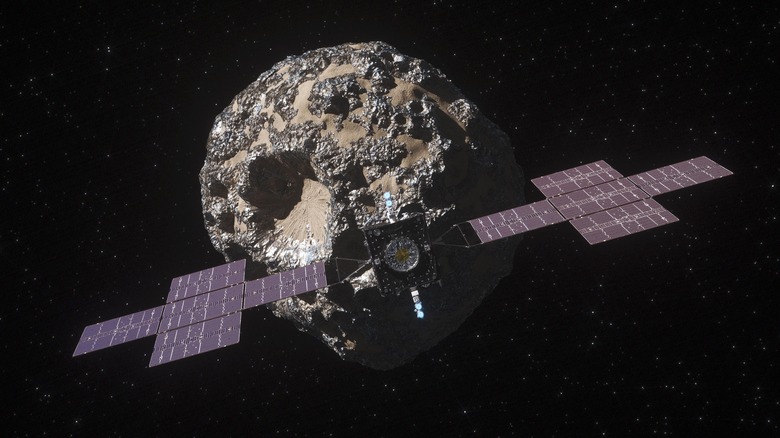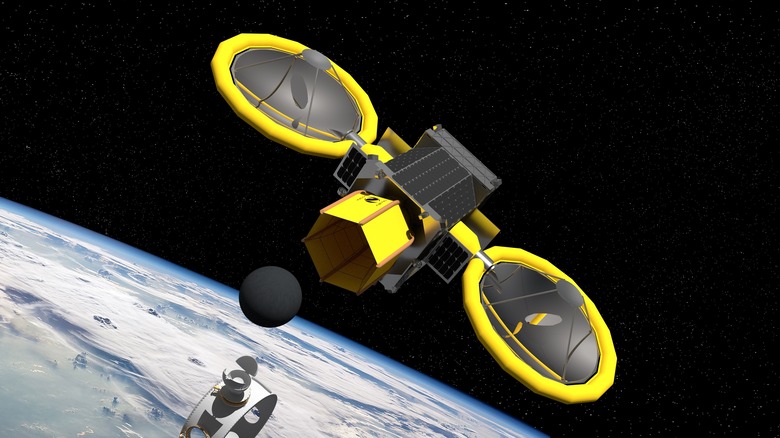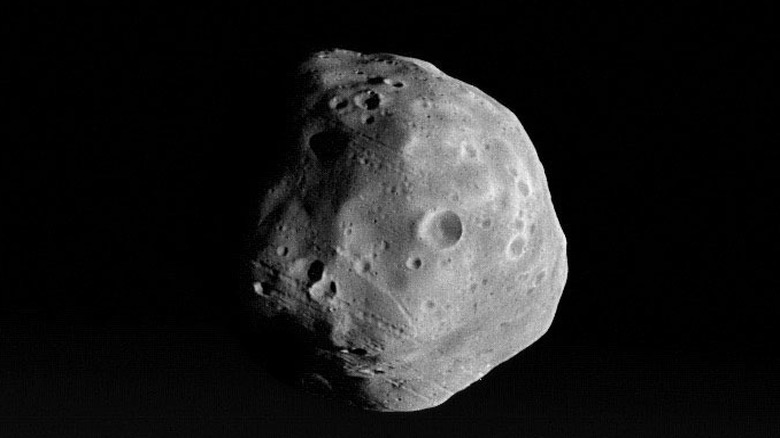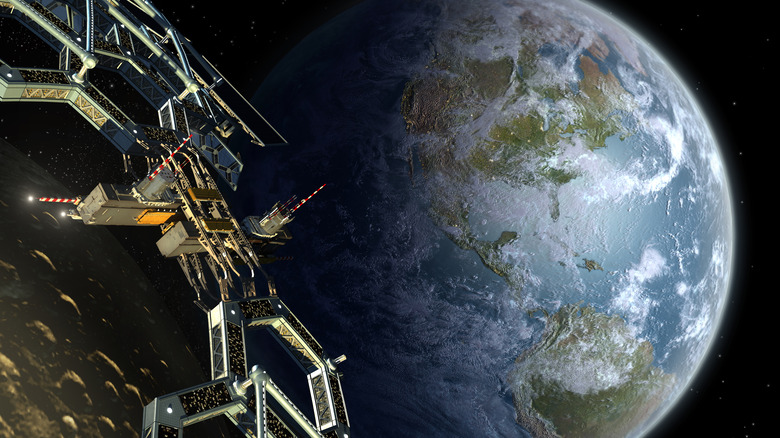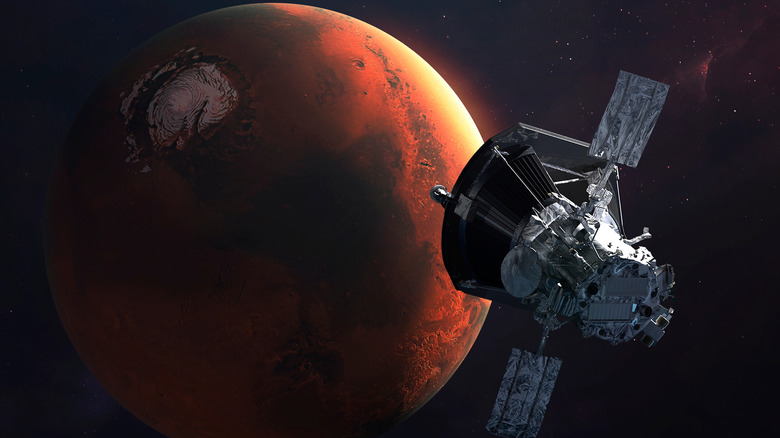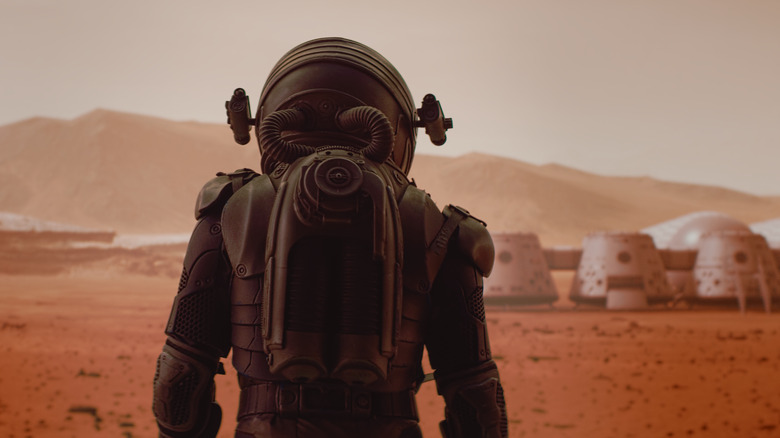Here's How Mars Could Play A Key Role In Asteroid Mining
The concept of mining asteroids for their mineral riches has long been a staple of science fiction, but the scientific expectations are realistic and private firms are already making moves to grab a piece of the pie. Even NASA is actively soliciting concepts and working models that could one day turn the dream into reality.
Take for example Mini Bee, a proposal that entered the Phase III studies within the NASA Innovative Advanced Concepts (NIAC) program back in 2019. The plan is to harvest water vapor and volatile chemical compounds from an asteroid using a technique called optical mining. The goal is to excavate the asteroid and collect target materials into a containment unit attached to the spacecraft.
However, sending a spacecraft to near-Earth asteroids is not the most economical idea, given their smaller size and mineral density. On a similar note, sending retrieval units to larger asteroids that are further away and maintaining a chain of transport between them and Earth won't exactly be cheap either.
This is where Mars and satellites come into the picture, providing closer access to the asteroid belt between Mars and Jupiter. Asteroids in our nearby asteroid belt are large and abundant, which means mining them would be easier and economically reasonable if a base was established on Mars or its natural satellites Phobos and Deimos. It might sound fantastical, but a few experts ran the numbers and propose that a Mars-based asteroid mining base would be the optimal strategy for asteroid mining.
Hurdles for asteroid mining
There are trillions of dollars worth of metal on asteroids floating in our galactic backyard, but mining it isn't really a cakewalk. At a point in human civilization where we have yet to start mining on Earth's natural satellite, dreaming about drilling on an asteroid at a commercial level sounds rather far-fetched. But even before we get ready with the necessary tech to start mining asteroids, scientists have already highlighted a bunch of practical hurdles before serious planning begins.
According to an in-depth analysis performed by the folks over at Caltech's Keck Institute for Space Studies in 2012, it would cost nearly $2.6 billion to capture and bring a near-Earth asteroid weighing about 500 tons close to Earth's orbit for mining. The first key challenge is coming up with a viable business model, one that goes beyond funding and takes into account the combined technical-economical side of such a venture. For example, how many spacecraft should be sent to capture an asteroid, considering the very real chances of failures along the way?
If one agrees to a swarm approach for sending spacecraft, exactly how many are needed to negate the risks and guarantee profits? The biggest question of them all has to do with ownership. Can any group of human beings have some sort of mutually agreed-upon mining claim to an object floating in space? Can a corporation skirt around regulations that are in place for Earthbound materials and mine an asteroid? Could an accord between space agencies be realized, even between nations that are otherwise hostile?
Why the Martian orbit?
For space missions, a key parameter for studying the feasibility is Delta-V, where delta stands for the magnitude of change and V denotes the velocity of the spacecraft. It takes into account the mass of a spacecraft to study the possibility of performing a certain maneuver such as launching from a surface or landing on it, and the approximate fuel requirements. In a paper published in Planetary and Space Science, astronomers from the Center for Astrophysics (Harvard & Smithsonian) determined that the Delta-V requirement for reaching a near-Earth asteroid is about 4 kilometers per second while reaching a main belt asteroid comes down to approximately 7 kilometers per second.
In the paper, the experts propose that a mission to mine Main Belt asteroids will be significantly more cost-efficient if a spacecraft was deployed from an orbit close — and similar — to that of Mars' natural satellites due to the lower Delta-V requirements. The conclusions were reached using a system developed by the experts called Python Asteroid Rendezvous Code (PARC).
The numbers suggest that using an orbit around Mars at an altitude of approximately 9,000 kilometers above the planet's surface would be properly energy efficient and technically feasible. If an orbit similar to that of Phobos is targeted for mining, the Delta-V for reaching approximately 100,000 marked main belt asteroids will be less than 4 kilometers per second. For an additional 340,000 asteroids, the Delta-V requirements were found to be below 5 kilometers per second.
What's the plan?
If an infrastructure that is capable of handling duties such as refueling, maintenance, and even exploration missions can be set up in Martian orbit, it would serve as an ideal path forward for mining asteroids. Such an orbital base would also help reduce the size and mass of spacecraft, which further helps tone down the cost of mining missions.
The team concluded that "Phobos is a convenient site for emplacing massive ore-refining equipment." Furthermore, Mars' natural satellite offers a few other benefits such as an inertial platform, gravity, and protection from radiation exposure to a certain extent. For example, it would be easier for machines to exert force on asteroid material when it's placed on Phobos' surface instead of trying to do so while floating close to an asteroid. The eccentric shape of Mars' orbit also offers some much-needed reduction in the mission's Delta-V requirements.
Once mining operations are established, they would also offer easier and more regular access to the Martian surface for research and exploration. If a base were in place on Phobos, space agencies would have a set landing place and base of operations between Earth and Mars, drastically reducing the cost of each subsequent mission to Mars. It'd be like building a house next to a goldmine instead of driving your vehicle from home every time you want to go spelunking.
Why are the Martian moons the key?
Another paper titled "Asteroid mining and the moons of Mars" which was published in Acta Astronautica all the way back in 1988 stresses the importance of asteroid mining close to the planet and how its natural satellites — Phobos and Deimos — play a critical role. Highlighting the core benefits of setting up a base on one of these satellites, the paper notes that "because of their low gravities, no fuel-consuming soft landings or blast-offs are needed as in the cases of Mars and the Moon."
Another advantage of setting up a base on one of these satellites is their reservoir of potentially critical resources. According to one round of research, up to 20% of these bodies might be loosely bound water, while another estimates it to be around 10%. Irrespective of the exact concentration, this water could be harvested for refueling missions and for sustaining life support systems.
It would be easier to send and remotely control survey rovers from the surface of Phobos and Deimos than it is deploying and operating one from a base station on Earth. The paper notes that in the context of mining resources outside the Earth, Phobos and Deimos will catalyze "an explosive human renaissance in space" and that they fulfill all the requisite scientific, economical, and technological rationales for taking the aforementioned steps.
From mining asteroids to settling on Mars
There is an abundance of obstacles that come with exploring the Martian surface. From technical challenges to funding problems, there are a lot of on-ground hurdles that scientists have had to consider before NASA's Artemis mission could even aim for a crewed mission to Mars. If there's already an orbital base close to Mars or established on one of its natural satellites with human activity supporting mining operations, it becomes a lot easier to launch Martian exploration operations.
The gravitational environment on Phobos would theoretically offer some respite from health effects like loss of bone mass that happens in microgravity. Stations established on the Martian satellite could also help recover from other adverse effects like accelerated aging. Once the exploration challenges have been handled, settlement goals can be chalked out.
Objectives like terraforming the Martian surface or executing other ambitious plans like erecting a magnetic shield to create a sustainable atmosphere may still be decades from fruition. Transporting resources to an established base on Phobos before they're used in missions on Mars might accelerate plans. It might only take the efforts of a single massive mission to get a vast array of future missions underway.
